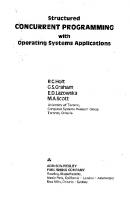Learn Concurrent Programming with Go (Final) 9781633438385
Write concurrent code in Go that improves application performance, scales up to handle bigger loads, and takes full adva
165 33 17MB
English Pages 392 Year 2023
Table of contents :
Inside front cover
Learn Concurrent Programming with Go
Copyright
contents
front matter
preface
acknowledgments
about this book
Who should read this book
How this book is organized: A road map
How to read the book
About the code
liveBook discussion forum
about the author
about the cover illustration
Part 1. Foundations
1 Stepping into concurrent programming
1.1 About concurrency
1.2 Interacting with a concurrent world
1.3 Increasing throughput
1.4 Improving responsiveness
1.5 Programming concurrency in Go
1.5.1 Goroutines at a glance
1.5.2 Modeling concurrency with CSP and primitives
1.5.3 Building our own concurrency tools
1.6 Scaling performance
1.6.1 Amdahl’s law
1.6.2 Gustafson’s law
Summary
2 Dealing with threads
2.1 Multiprocessing in operating systems
2.2 Abstracting concurrency with processes and threads
2.2.1 Concurrency with processes
2.2.2 Creating processes
2.2.3 Using multiprocessing for common tasks
2.2.4 Concurrency with threads
2.2.5 A multithreaded application in practice
2.2.6 Using multiple processes and threads together
2.3 What’s so special about goroutines?
2.3.1 Creating goroutines
2.3.2 Implementing goroutines in the user space
2.3.3 Scheduling goroutines
2.4 Concurrency versus parallelism
2.5 Exercises
Summary
3 Thread communication using memory sharing
3.1 Sharing memory
3.2 Memory sharing in practice
3.2.1 Sharing a variable between goroutines
3.2.2 Escape analysis
3.2.3 Updating shared variables from multiple goroutines
3.3 Race conditions
3.3.1 Stingy and Spendy: Creating a race condition
3.3.2 Yielding execution does not help with race conditions
3.3.3 Proper synchronization and communication eliminate race conditions
3.3.4 The Go race detector
3.4 Exercises
Summary
4 Synchronization with mutexes
4.1 Protecting critical sections with mutexes
4.1.1 How do we use mutexes?
4.1.2 Mutexes and sequential processing
4.1.3 Non-blocking mutex locks
4.2 Improving performance with readers–writer mutexes
4.2.1 Go’s readers–writer mutex
4.2.2 Building our own read-preferred readers–writer mutex
4.3 Exercises
Summary
5 Condition variables and semaphores
5.1 Condition variables
5.1.1 Combining mutexes with condition variables
5.1.2 Missing the signal
5.1.3 Synchronizing multiple goroutines with waits and broadcasts
5.1.4 Revisiting readers–writer locks using condition variables
5.2 Counting semaphores
5.2.1 What’s a semaphore?
5.2.2 Building a semaphore
5.2.3 Never miss a signal with semaphores
5.3 Exercises
Summary
6 Synchronizing with waitgroups and barriers
6.1 Waitgroups in Go
6.1.1 Waiting for tasks to complete with waitgroups
6.1.2 Creating a waitgroup type using semaphores
6.1.3 Changing the size of our waitgroup while waiting
6.1.4 Building a more flexible waitgroup
6.2 Barriers
6.2.1 What is a barrier?
6.2.2 Implementing a barrier in Go
6.2.3 Concurrent matrix multiplication using barriers
6.3 Exercises
Summary
Part 2. Message passing
7 Communication using message passing
7.1 Passing messages
7.1.1 Passing messages with channels
7.1.2 Buffering messages with channels
7.1.3 Assigning a direction to channels
7.1.4 Closing channels
7.1.5 Receiving function results with channels
7.2 Implementing channels
7.2.1 Creating a channel with semaphores
7.2.2 Implementing the Send() function in our channel
7.2.3 Implementing the Receive() function in our channel
7.3 Exercises
Summary
8 Selecting channels
8.1 Combining multiple channels
8.1.1 Reading from multiple channels
8.1.2 Using select for non-blocking channel operations
8.1.3 Performing concurrent computations on the default case
8.1.4 Timing out on channels
8.1.5 Writing to channels with select
8.1.6 Disabling select cases with nil channels
8.2 Choosing between message passing and memory sharing
8.2.1 Balancing code simplicity
8.2.2 Designing tightly versus loosely coupled systems
8.2.3 Optimizing memory consumption
8.2.4 Communicating efficiently
8.3 Exercises
Summary
9 Programming with channels
9.1 Communicating sequential processes
9.1.1 Avoiding interference with immutability
9.1.2 Concurrent programming with CSP
9.2 Reusing common patterns with channels
9.2.1 Quitting channels
9.2.2 Pipelining with channels and goroutines
9.2.3 Fanning in and out
9.2.4 Flushing results on close
9.2.5 Broadcasting to multiple goroutines
9.2.6 Closing channels after a condition
9.2.7 Adopting channels as first-class objects
9.3 Exercises
Summary
Part 3. More concurrency
10 Concurrency patterns
10.1 Decomposing programs
10.1.1 Task decomposition
10.1.2 Data decomposition
10.1.3 Thinking about granularity
10.2 Concurrency implementation patterns
10.2.1 Loop-level parallelism
10.2.2 The fork/join pattern
10.2.3 Using worker pools
10.2.4 Pipelining
10.2.5 Pipelining properties
10.3 Exercises
Summary
11 Avoiding deadlocks
11.1 Identifying deadlocks
11.1.1 Picturing deadlocks with resource allocation graphs
11.1.2 Deadlocking in a ledger
11.2 Dealing with deadlocks
11.2.1 Detecting deadlocks
11.2.2 Avoiding deadlocks
11.2.3 Preventing deadlocks
11.3 Deadlocking with channels
11.4 Exercises
Summary
12 Atomics, spin locks, and futexes
12.1 Lock-free synchronization with atomic variables
12.1.1 Sharing variables with atomic numbers
12.1.2 Performance penalty when using atomics
12.1.3 Counting using atomic numbers
12.2 Implementing a mutex with spin locks
12.2.1 Comparing and swapping
12.2.2 Building a mutex
12.3 Improving on spin locking
12.3.1 Locking with futexes
12.3.2 Reducing system calls
12.3.3 Go’s mutex implementation
12.4 Exercises
Summary
index
Inside back cover
Inside front cover
Learn Concurrent Programming with Go
Copyright
contents
front matter
preface
acknowledgments
about this book
Who should read this book
How this book is organized: A road map
How to read the book
About the code
liveBook discussion forum
about the author
about the cover illustration
Part 1. Foundations
1 Stepping into concurrent programming
1.1 About concurrency
1.2 Interacting with a concurrent world
1.3 Increasing throughput
1.4 Improving responsiveness
1.5 Programming concurrency in Go
1.5.1 Goroutines at a glance
1.5.2 Modeling concurrency with CSP and primitives
1.5.3 Building our own concurrency tools
1.6 Scaling performance
1.6.1 Amdahl’s law
1.6.2 Gustafson’s law
Summary
2 Dealing with threads
2.1 Multiprocessing in operating systems
2.2 Abstracting concurrency with processes and threads
2.2.1 Concurrency with processes
2.2.2 Creating processes
2.2.3 Using multiprocessing for common tasks
2.2.4 Concurrency with threads
2.2.5 A multithreaded application in practice
2.2.6 Using multiple processes and threads together
2.3 What’s so special about goroutines?
2.3.1 Creating goroutines
2.3.2 Implementing goroutines in the user space
2.3.3 Scheduling goroutines
2.4 Concurrency versus parallelism
2.5 Exercises
Summary
3 Thread communication using memory sharing
3.1 Sharing memory
3.2 Memory sharing in practice
3.2.1 Sharing a variable between goroutines
3.2.2 Escape analysis
3.2.3 Updating shared variables from multiple goroutines
3.3 Race conditions
3.3.1 Stingy and Spendy: Creating a race condition
3.3.2 Yielding execution does not help with race conditions
3.3.3 Proper synchronization and communication eliminate race conditions
3.3.4 The Go race detector
3.4 Exercises
Summary
4 Synchronization with mutexes
4.1 Protecting critical sections with mutexes
4.1.1 How do we use mutexes?
4.1.2 Mutexes and sequential processing
4.1.3 Non-blocking mutex locks
4.2 Improving performance with readers–writer mutexes
4.2.1 Go’s readers–writer mutex
4.2.2 Building our own read-preferred readers–writer mutex
4.3 Exercises
Summary
5 Condition variables and semaphores
5.1 Condition variables
5.1.1 Combining mutexes with condition variables
5.1.2 Missing the signal
5.1.3 Synchronizing multiple goroutines with waits and broadcasts
5.1.4 Revisiting readers–writer locks using condition variables
5.2 Counting semaphores
5.2.1 What’s a semaphore?
5.2.2 Building a semaphore
5.2.3 Never miss a signal with semaphores
5.3 Exercises
Summary
6 Synchronizing with waitgroups and barriers
6.1 Waitgroups in Go
6.1.1 Waiting for tasks to complete with waitgroups
6.1.2 Creating a waitgroup type using semaphores
6.1.3 Changing the size of our waitgroup while waiting
6.1.4 Building a more flexible waitgroup
6.2 Barriers
6.2.1 What is a barrier?
6.2.2 Implementing a barrier in Go
6.2.3 Concurrent matrix multiplication using barriers
6.3 Exercises
Summary
Part 2. Message passing
7 Communication using message passing
7.1 Passing messages
7.1.1 Passing messages with channels
7.1.2 Buffering messages with channels
7.1.3 Assigning a direction to channels
7.1.4 Closing channels
7.1.5 Receiving function results with channels
7.2 Implementing channels
7.2.1 Creating a channel with semaphores
7.2.2 Implementing the Send() function in our channel
7.2.3 Implementing the Receive() function in our channel
7.3 Exercises
Summary
8 Selecting channels
8.1 Combining multiple channels
8.1.1 Reading from multiple channels
8.1.2 Using select for non-blocking channel operations
8.1.3 Performing concurrent computations on the default case
8.1.4 Timing out on channels
8.1.5 Writing to channels with select
8.1.6 Disabling select cases with nil channels
8.2 Choosing between message passing and memory sharing
8.2.1 Balancing code simplicity
8.2.2 Designing tightly versus loosely coupled systems
8.2.3 Optimizing memory consumption
8.2.4 Communicating efficiently
8.3 Exercises
Summary
9 Programming with channels
9.1 Communicating sequential processes
9.1.1 Avoiding interference with immutability
9.1.2 Concurrent programming with CSP
9.2 Reusing common patterns with channels
9.2.1 Quitting channels
9.2.2 Pipelining with channels and goroutines
9.2.3 Fanning in and out
9.2.4 Flushing results on close
9.2.5 Broadcasting to multiple goroutines
9.2.6 Closing channels after a condition
9.2.7 Adopting channels as first-class objects
9.3 Exercises
Summary
Part 3. More concurrency
10 Concurrency patterns
10.1 Decomposing programs
10.1.1 Task decomposition
10.1.2 Data decomposition
10.1.3 Thinking about granularity
10.2 Concurrency implementation patterns
10.2.1 Loop-level parallelism
10.2.2 The fork/join pattern
10.2.3 Using worker pools
10.2.4 Pipelining
10.2.5 Pipelining properties
10.3 Exercises
Summary
11 Avoiding deadlocks
11.1 Identifying deadlocks
11.1.1 Picturing deadlocks with resource allocation graphs
11.1.2 Deadlocking in a ledger
11.2 Dealing with deadlocks
11.2.1 Detecting deadlocks
11.2.2 Avoiding deadlocks
11.2.3 Preventing deadlocks
11.3 Deadlocking with channels
11.4 Exercises
Summary
12 Atomics, spin locks, and futexes
12.1 Lock-free synchronization with atomic variables
12.1.1 Sharing variables with atomic numbers
12.1.2 Performance penalty when using atomics
12.1.3 Counting using atomic numbers
12.2 Implementing a mutex with spin locks
12.2.1 Comparing and swapping
12.2.2 Building a mutex
12.3 Improving on spin locking
12.3.1 Locking with futexes
12.3.2 Reducing system calls
12.3.3 Go’s mutex implementation
12.4 Exercises
Summary
index
Inside back cover




![Learn Concurrent Programming with Go [MEAP v5 ed.]
1633438384, 9781633438385](https://ebin.pub/img/200x200/learn-concurrent-programming-with-go-meap-v5nbsped-1633438384-9781633438385-w-8216103.jpg)
![Learn Concurrent Programming with Go [MEAP v5 ed.]
1633438384, 9781633438385](https://ebin.pub/img/200x200/learn-concurrent-programming-with-go-meap-v5nbsped-1633438384-9781633438385.jpg)




